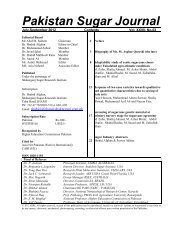Pakistan Sugar Journal - Shakarganj
Pakistan Sugar Journal - Shakarganj
Pakistan Sugar Journal - Shakarganj
You also want an ePaper? Increase the reach of your titles
YUMPU automatically turns print PDFs into web optimized ePapers that Google loves.
Muhammad Zafar et al.<br />
After comparing the quantitative and qualitative characters of all clones with standard Variety, 133 clones<br />
were promoted to preliminary varietal trial, while 118 clones (47%) were rejected due to undesirable<br />
characters. The committee of experts made the selection in the field.<br />
RESULTS AND DISCUSSION<br />
The results of the performance of clones under evaluation of varietals selection performance are given in<br />
table-2 and 1 significant clones (133) were selected as given in the table-1 and clones which fell under<br />
the categories of unrequited characters of sugarcane plant are given in the table-2. In table-1 (20) parent<br />
gave highest selection %age of 100 followed by parent CP84-98 X CP84-1274 and parent CP78-2114 X<br />
CP92-P3.<br />
These exhibit 85.71% and 83.33% selection for promotion to advance nursery. So the selection remained<br />
53% that is 133 clones and rejection was 47% that is 118 clones.<br />
Parameters studied in experiment are discussed as under.<br />
1. Growth performance: In good agronomic practices the growth performance is a character that affect<br />
the yield of cane crop. Growth habits, erectness, internodal length, girth of cane, length of cane and stooling<br />
depends upon genetic make up which may be detected by the over all performance of clone. So 6<br />
clones (2.39%) were rejected on the basis of poor growth.<br />
2. Pithiness: Hollow stem of cane is negative character, leads to lodging and disease infestation and<br />
lowers the cane quality. In the trial 14 clones (5.58%) were rejected due to pithiness.<br />
3. Brix %age: It is the percentage by weight of sucrose in pure sugar solution (Meade 1964). It was recorded<br />
by hand refractometer. Higher brix %age will result in higher sugar recovery and vice versa. In<br />
this context 28 clones (11.15%) were rejected due to low brix %age.<br />
4. Aerial roots: These are secondary roots which spoil the quality of the cane as well as lowers the<br />
growth speed and deteriorate the crop stand 12 clones (4.78%) were found carrier of bad character so<br />
were rejected.<br />
5. Cracks: These are the cracks on stem of the cane plant. These deteriorate the cane quality as well as<br />
tissues due to enhancement of the transpiration rate (Dillewijn 1952) and make s susceptible plant to the<br />
disease attack 7 clones (2.79%) showed this undesirable character and were rejected.<br />
6. Sprouts: These are the buds sprouting which adversely affect the quality of the cane and germination<br />
of the new crop is lowered if sets are affected by sprouting. These characters appeared in 14 clones<br />
(5.58%) and theses were rejected in this trial.<br />
7. Disease infestation: Only 13 clones (5.18%) were rejected due to severe attack of different diseases in<br />
this trial.<br />
8. Insect/ Pest: Insect pest attack was observed on 7 clones (2.788%) and these were rejected.<br />
9. Lodging: Lodging exerts harmful effects on sugar yield (Borden 1942). Spoils the cane quality, brix%<br />
age and growth of the sugar cane crop. So 17 clones 6.773% showed lower resistance for lodging and<br />
hence were rejected.<br />
<strong>Pakistan</strong> <strong>Sugar</strong> <strong>Journal</strong> April-June 2012 12






